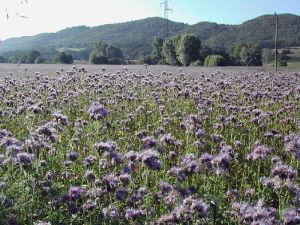Phacelia

Phacelia tanacetifolia is an annual herbaceous plant in the Hydrophyllaceae family (Boraginaceae according to the phylogenetic classification).
Native to northern Mexico and southern California, this plant is of particular interest in agriculture and beekeeping.
Description
- The stem : full and rigid, covered with stiff hairs and fairly thick, up to a metre long, is tinged with red. It has a dense root system.
- The leaves : alternate, deeply divided and reminiscent of tansy (Tanecetum).
- The flowers : very fragrant, grouped in tightly packed cyme-like scorpioid inflorescences (in the shape of a crescent which gradually unfurls as the small 1 cm flowers open out, starting at the top). The floral elements are shades of lavender-blue ; the five stamens and two styles emerge clearly from the five-petalled corolla. The calyx is narrow with hairy sepals. The flowering period is in spring and can extend into autumn.
- The fruits : are small dehiscent capsules containing two to four small black seeds (3 mm long).
-
Crosses florales de phacélie.
-
Graines et capsules de phacélie.
-
Graines - Muséum de Toulouse
-
Phacelia tanacetifolia et gel, à Dülmen, Allemagne.
Distribution
This species is native to the southern United States (California, Arizona, Nevada) and northern Mexico.
It is cultivated and has become naturalised in temperate regions on other continents.
Cultivation
A field of phacelia. The plant grows naturally in fairly dry soil. It takes 3 to 4 months to mature.
As a honey plant, phacelia is sown at lower rates (6 to 8 kg/ha) than as a green manure. When the seeding rate exceeds 10 kg/ha, the sugar content of the nectar decreases because the plants are smaller and grow more slowly. Sowing too densely will shorten the flowering period.
If you need to sow in summer, white mustard is more suitable than phacelia.
When phacelia produces viable seeds, it can itself become an invasive plant.
Multiplication
The only propagation method used is sowing, which is carried out after the last frosts in spring, sowing at a depth of 0.5 cm to ensure that the seed remains in the dark, which is essential for germination. Freshly harvested phacelia seeds germinate poorly at 20-30°C but well at 10°C. Phacelia seed remains dormant for at least two months after harvesting.
Phacelia seed keeps for three to four years under normal conditions and up to six years under optimum conditions. Young seed can germinate at 5°C, older seed only in warm soil.
Use
Phacelia has three main uses in agriculture :
- Its flowers are particularly attractive to syrphid flies (helophiles), carabid beetles, bombylids and aphelinidae, which feed on aphids in the surrounding area. Some fields have been planted with phacelia to reduce the number of aphids.
An excellent honey plant, phacelia also attracts bees, which are pollinators that can be useful to neighbouring plants. By sowing continuously from May to late summer, you can also achieve continuous flowering from July to autumn. Phacelia honey is highly fragrant.
- In autumn, the plant makes a good green manure. Phacelia as a green manure is sometimes sown in association with other species, for example with buckwheat at a rate of 8 kg/ha of phacelia for 40 kg/ha of buckwheat or with lupins at a rate of 5 kg/ha of phacelia for 150 kg/ha of lupins. When planted over large areas, it has the ability to eliminate weeds such as couch grass.
- Sown between the rows of young apple and pear trees, phacelia halves the mortality of young trees in years of serious winter damage. Phacelia as a ground cover also has a favourable effect on the growth of young apple trees. Care should be taken to ensure that the flowering periods of fruit trees and phacelia do not coincide, as bees will favour phacelia.
Phacelia is particularly recommended for orchards of fruit trees, as it also helps to boost the populations of Trichogramma, micro-hymenoptera that parasitise the eggs of Lepidoptera, including codling moths (apple and plum worms). The plant also attracts the wasp Aphelinus mali, which parasitises the woolly apple aphid.